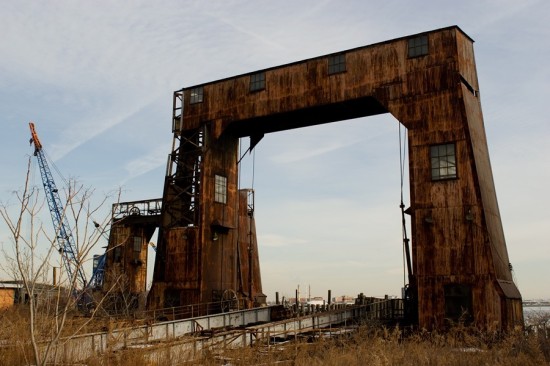
New use sought for rusting Port Morris towers
The word “gantry” doesn’t mean anything to longtime bakery owner Errol Bier, but when he sees a photo of the rusted, towering structures that stand next to his Port Morris shop, he nods.
“That’s where I used to ride the ferry,” said Bier, who owns Miss Grimble on 135th and Locust Ave.
Bier, who has been coming to the neighborhood since he was a child, recalled a time when the gantries were filled with passengers going to visit family members interned at Rikers Island. Today, the massive structures stand desolate in a fenced-in field of weeds, surrounded by construction cranes and “No Trespassing” signs.
But the local community group Friends of Brook Park has big plans for the site. Its members want to turn it into a waterfront recreational area in a neighborhood starved for open space.
Earlier this month, the Historic Districts Council, an advocacy group that fights to preserve New York City neighborhoods, put the site on its highly selective annual list of historic sites in need of protection. The council says it will collaborate with the Brook Park group to try to get the gantry site on the National Register of Historic Places.
“We don’t often visit places like this that are so visually striking and make you feel as though you’re experiencing a different time in history,” said Simeon Bankoff, the preservation group’s executive director. “It really brings us back to our foundation and reminds us that New York is a city about water. It’s a really evocative space to think about new opportunities for the community.”
The two structures were built a century ago to load cargo and passengers onto ferries that sailed to Queens and back.
Randall Comfort, in his 1906 book “History of the Bronx Borough, City of New York,” described the opening of the ferry station. “The beautiful, tastefully, and practically arranged ferry house became the talk of the whole Borough of the Bronx, and now especially on a fine summer day, it is a great sight to see the throngs go over the ferry to North Beach,” he wrote.
After the private company that owned the gantries and ferries dissolved in 1918, the city cut service, opting to run ferries only to Rikers for inmates and their families, and to North Brother Island for patients at the sanatorium.
The ferries continued to operate until the mid-1960s when the Francis Buono Bridge, better known as the Rikers Island Bridge, was built and the North Brother hospital was mothballed, making ferry service to the islands unnecessary. North Brother is now a protected bird sanctuary owned by the Parks Department, which has worked with teens at The Point Community Development Corp. to restore native plants.
Harry Bubbins, director of Friends of Brook Park, has been working with architects from City College’s School of Architecture to attain historic preservation status for the site, and envisions turning it into an educational hub that would combine art and ecology lessons for the public, similar to a site in Queens that turned its rusted gantries into a public education space. Bubbins sees the Historic Council’s ’s selection of the site as a first step.
“There’s six miles of shore where there’s no waterfront access,” said Bubbins. “It’s an absolute tragedy.”
The project has received support from Congressman Jose Serrano, who in a June 2010 letter to the state’s Office of Historic Preservation said, “The Morris Gantries are the last historic vestige of the South Bronx’s once thriving industrial waterfront. The gantries have been in existence for many decades and remain a striking visual reminder of a time when our waterways were utilized by substantial numbers of New Yorkers.”
Bubbins says local residents should be encouraged to visit the gantries, but some Port Morris residents don’t agree. John Lekas, who lives in the neighborhood and owns the Locust Restaurant, is skeptical a recreational space in this isolated industrial neighborhood can succeed.
“This isn’t the kind of neighborhood where people come and sit outside with a magazine,” said Lekas. “People come here to work, or for temporary residence.”
Errol Bier, whose bakery has existed for almost as long as the gantries, thinks a park would be uplifting, and would be good for businesses like his and Lekas’s.
“It would beautify the neighborhood,” said Bier. “And maybe then people will stop building recycling plants here.”

[…] their first goal would be to create a park on the eastern edge of 132nd Street. Another park at the historic Gantry site on 134th Street is scheduled to follow, along with a greenway connecting both parks to Randall’s […]